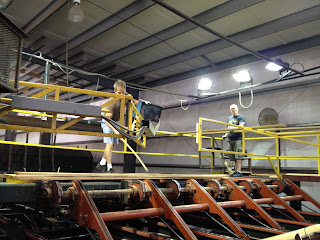Frank E. Wilson Lumber Co. Inc. is located in Elkins, WV. They produce green stock and a broad range of kiln dried Appalachian Hardwoods (Ash, Basswood, Cherry, Maple, Oak, Hickory, Poplar, and Walnut), supplying both rough and surfaced lumber. There is currently between 1.25 and 1.5 million board feet of lumber here.
The process:
Step 1 - Purchase green lumber from sawmills and grade it according to species, length, grade, and footage. Most of their wood comes from a 100 mile radius.
 |
| The inspector has approximately 3 seconds to check the quality of the board and assign a grade to it. A scanner then measures the board. |
 |
| This grader measures board footage using a special tool. |
 |
| The tool used to quickly measure board footage. |
(Wet weight - Dry weight) / Dry weight = Moisture content (in %)
 |
| Wet wood is stacked in the kiln. |
 |
| 10 2-ft boards are used as samples to be tested daily for moisture content. |
 |
| Wood remains in the kiln until the moisture content (as shown by this drying guide) is around 6%. |
 |
| Moisture contents of each sample is carefully recorded each day. These results determine when to raise the temperature in the kilns. |
 |
| Temperature recorder for one of the kilns. The red indicates the dry temperature while the green is the wet temperature. |
Wilson Quality Millworks, Inc. is a sister company to the lumber company. Approximately 70% of the wood (mostly maple, oak, and poplar) they use come from the adjacent lumber company, but it is run as a separate business. They have stock molding, hand rails, etc... but also create custom molding. (The customer must be willing to pay a set up cost of approximately $300 for the custom knife.)
The Process:
Step 1 - Use a computer to draw a profile of the molding to be created.
Step 2 - Cut a plastic template which is used to cut the custom knife (made of steel or carbide).
Step 4 - The molding is passed through a sander and, if the customer desires, it will be stained, painted, and/or sealed before being shipped.




Excellent information and supporting photos.
ReplyDeleteThanks!
I like the way you took us throuh the whole process, Bethany.
ReplyDelete